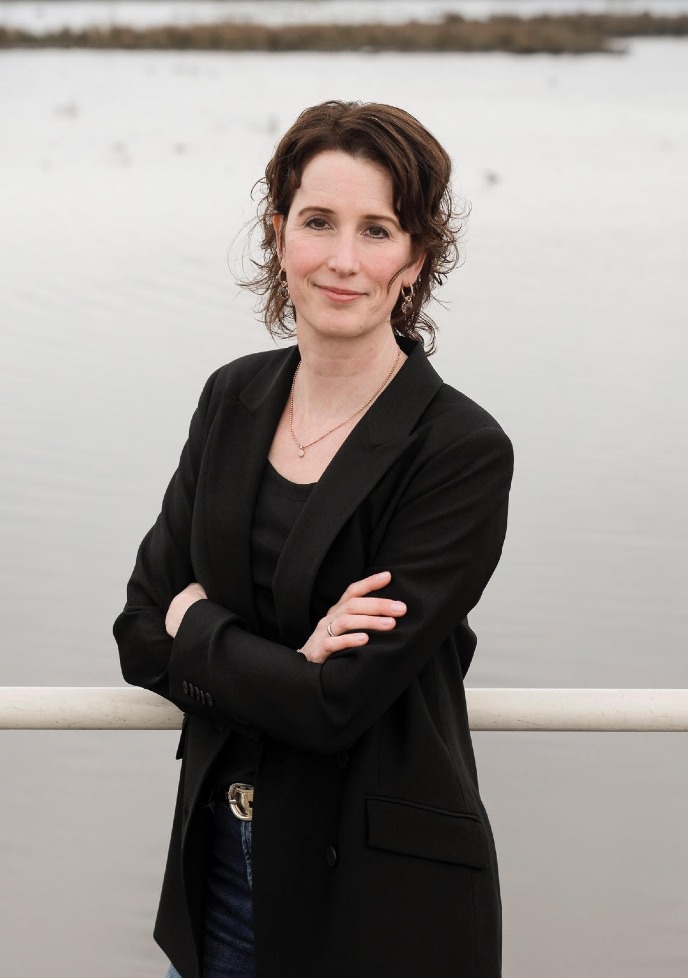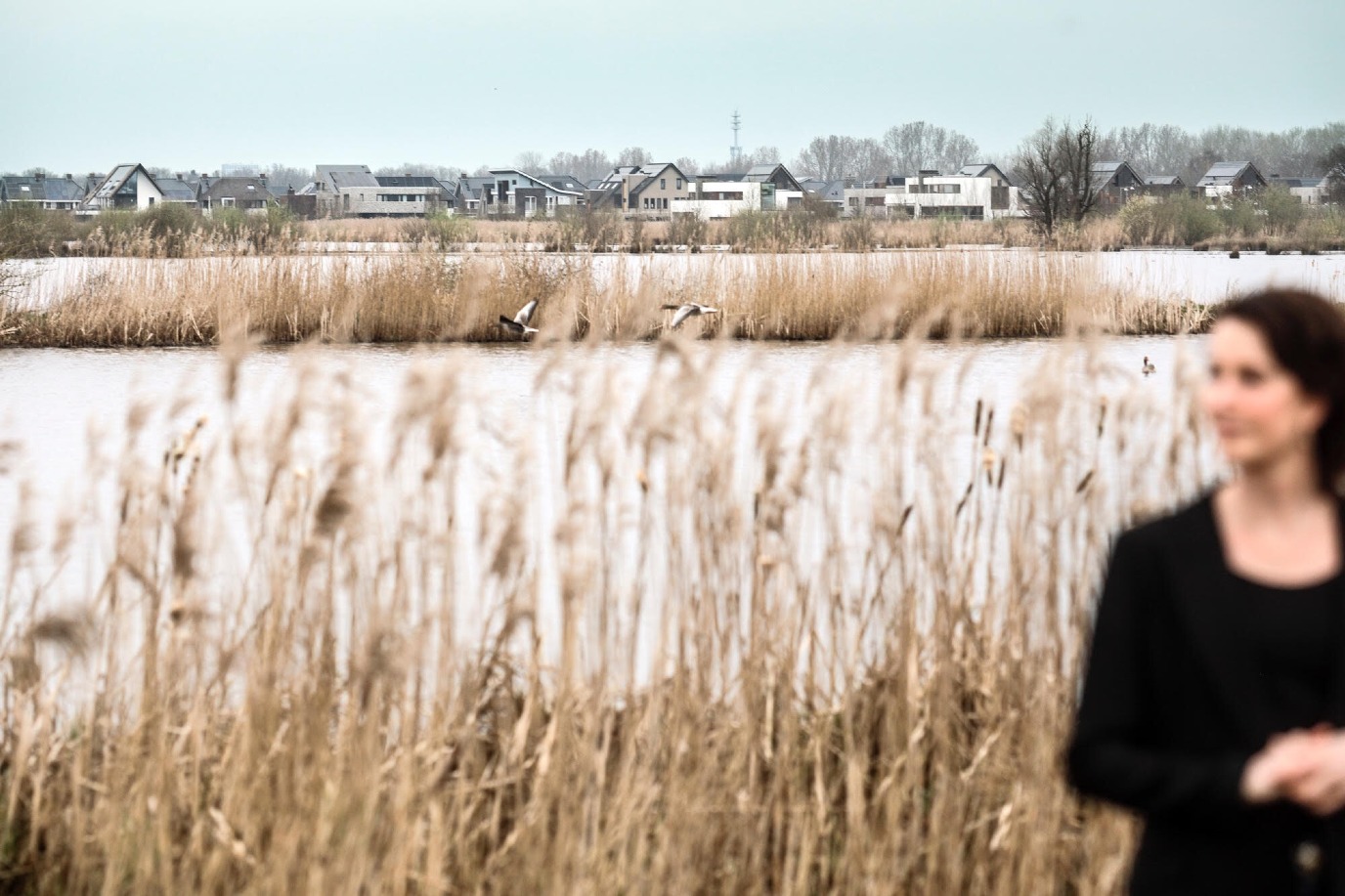From battling against the water to living with the water

Extreme showers, heat waves, floods, and rising sea levels are all threats to our low-lying delta. Margo van den Brink, associate professor of Water and Planning, says that we should adapt our spatial design to the changing climate. This implies difficult choices have to be made because the space is limited and the needs are great. According to her, it can be called a transition: from ‘battling against the water’ to ‘living with the water’.
Text: Martin Althof, Corporate Communication / Photos: Henk Veenstra
Transition
Ever since she studied Cultural Studies in Maastricht, Van den Brink has been interested in the ongoing transition in water management and water policy to overcome the consequences of climate change. ‘I developed this interest during my internship at the former Road and Hydraulic Engineering Institute of the Directorate-General for Public Works and Water Management. There, I witnessed for the first time a growing doubt about the viability of our age-old battle against the water using dykes and other flood defences. Solely employing traditional technical water management was increasingly regarded as insufficient. Dykes remain necessary, but there is a growing understanding that a higher flood resilience also requires more room for water.’
Room for the river
Van den Brink says that a number of things were reflected in the innovative project Room for the River (‘Ruimte voor de Rivier’) that was launched after the great floods in 1993 and 1995, when the water levels of the great rivers rose to alarming heights. Naturally, the dykes were then heightened and improved. But that was not all: ‘An extensive programme was set up to make the river region safer and more attractive, i.e. to improve both the water safety and the spatial quality of the river region, with spatial measures at the heart of it. The rivers were literally given more room by shifting dykes, lowering or digging out washland, digging secondary channels, and depoldering areas. After the extreme rainfall of 1998, water storage area De Onlanden was created near the city of Groningen for that same reason by the way.’

There's more than one way
Room for the River is nearly completed and Van den Brink is very happy with the results: ‘Not just because we succeeded in limiting the flood risks but definitely also because in many places the spatial quality has been improved. Think of, for example, nature development, attention for cultural history, and the creation of recreational opportunities. All parties involved in the project worked closely together under central leadership, which worked well. I’m thrilled that I soon get to contribute to a book about what we can learn from government successes, Room for the River being one of them. The working title of the book is Zo kan het ook [There’s more than one way].’
Flood Protection Programme
Here, too, applies that results obtained in the past are no guarantee for the future. In the current Flood Protection Programme (Hoogwaterbeschermingsprogramma, HWBP), the largest dyke reinforcement operation since the Delta Works, the double objective of water safety and spatial quality has been dropped. ‘The subtitle of the programme is ‘for strong dykes’. In my opinion, this is really taking a step back, back to a focus on technical dyke reinforcement measures, back to a focus on water safety. Spatial quality is no longer a main objective but is now by and large left to the separate project teams. In those teams, the spatial expertise and financial resources are, at the time being, often limited, which in practice leads to frugal dyke reinforcement projects.’

Permanent attiontion to spatial quality
For that reason, the universities of Groningen and Wageningen have taken the initiative to conduct further research into the question what spatial quality entails and how it can be safeguarded in the planning process of water safety projects. Other parties, such as various water boards, consulting firms, and design agencies, also found this important and co-funded the research. The study has recently been concluded with the presentation of an interactive advisory report. Van den Brink: ‘It’s really time for what we call a ‘quality reversal’, in which it is important to look at the quality of entire dyke landscapes and not just at the dyke as water barrier. What also really helps is to solidify the embedding of spatial quality as an objective, both on a project and a programme level. Explicit attention to spatial quality and integrated area development offers opportunities for creating support and for searching for innovative solutions and funding possibilities. Essential to this, however, is the creation of shared ownership between all parties involved in an area. This also has consequences for the working method and the culture of traditionally technical organizations, such as the Directorate-General for Public Works and Water Management and the water boards, that will have to take a much more proactive attitude as ‘area partners’. Spatial knowledge and expertise are also needed, and people who are able to play an integrating role in a project team. People who can listen and unify, I call them ‘cross-border workers’.’
Floating Future
The latter certainly applies to the new interdisciplinary research project Van den Brink is working on, Floating Future, funded by the Dutch Research Council (NWO). ‘MARIN, the Maritime Research Institute Netherlands, has the lead in this project, which has a duration of five years and involves a lot of different parties. The central question is: how can we lay a foundation together under a floating future? Is it possible, for example, to live on water on a large scale? We are all familiar with houseboats, of course. But scaling up is the issue here, so an apartment building, for example, or even a residential district on the water, on a floating platform. This scaling up involves various aspects that require further examination: how can this be made possible, technically speaking? What about the legal, ecological, and administrative sides? And, of course, is it economically feasible? Another important question is: do people want to have a floating house, i.e. what about the societal acceptance? In Groningen, we will mainly look into this question, so how could living in a floating house be made into an attractive future prospect for potential residents and users, and not just for the happy few. Another question is how the scaling up should be organized policy-wise.’

Involve all parties
Now more than ever it seems like pure necessity to involve all parties in this innovative project. Van den Brink: ‘We will therefore not be sketching the possibilities for a floating future ourselves as researchers. We will in fact explore and design the floating future in an interactive way, together with all potential users, residents, representatives of governments, and groups of stakeholders. During the study, we will therefore involve them in many different ways to make sure we take these steps together, through co-creation. We will be organizing ‘Climate Cafés’, for example, together with Hanze University of Applied Sciences.’ Van den Brink is aware that everything will take time: ‘A city on the sea is still a bridge too far. It makes sense to start in and near the city, where societal acceptance and feasibility is probably largest.’
More information
-
The research project 'Ruimtelijke kwaliteit in waterveiligheidsbeheer'
| Last modified: | 02 May 2024 09.35 a.m. |
More news
-
11 March 2025
East Groningen: universal basic services must be up to standard
Sjierdan Koster makes the case for long-term thinking and for bringing Groningen’s universal basic services up to standard.
-
05 March 2025
Women in Science
The UG celebrates International Women’s Day with a special photo series: Women in Science.
-
11 February 2025
Space for your disability
When it comes to collaborations between researchers from different faculties, the UG is at the top of its game. A prime example is the Disabled City project that researches how the mobility of people with a physical disability can be explored...
